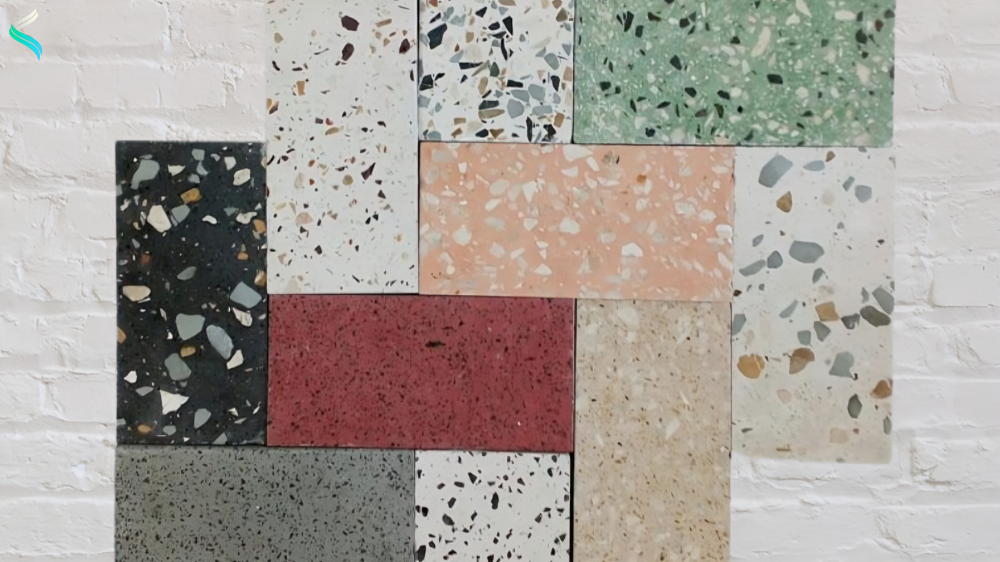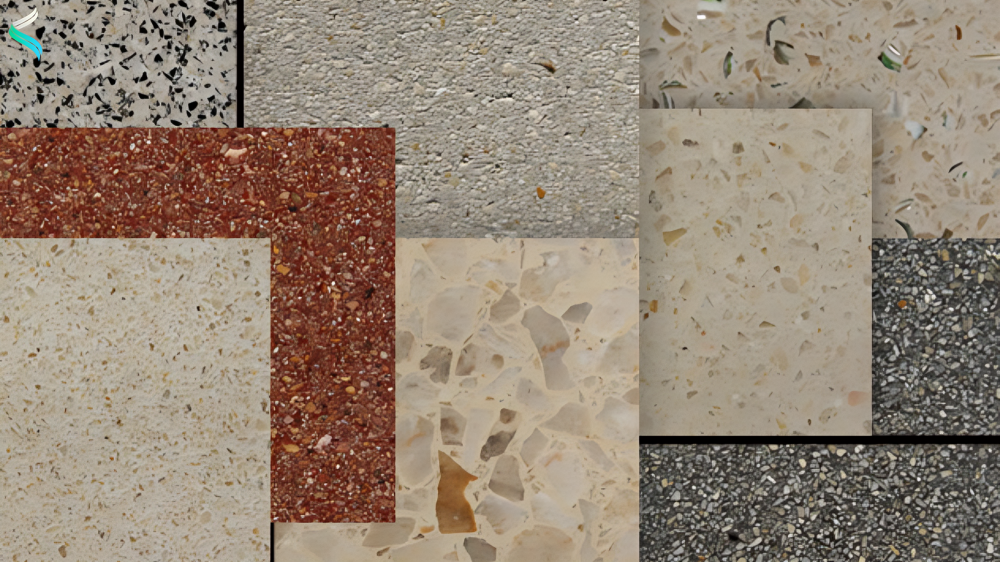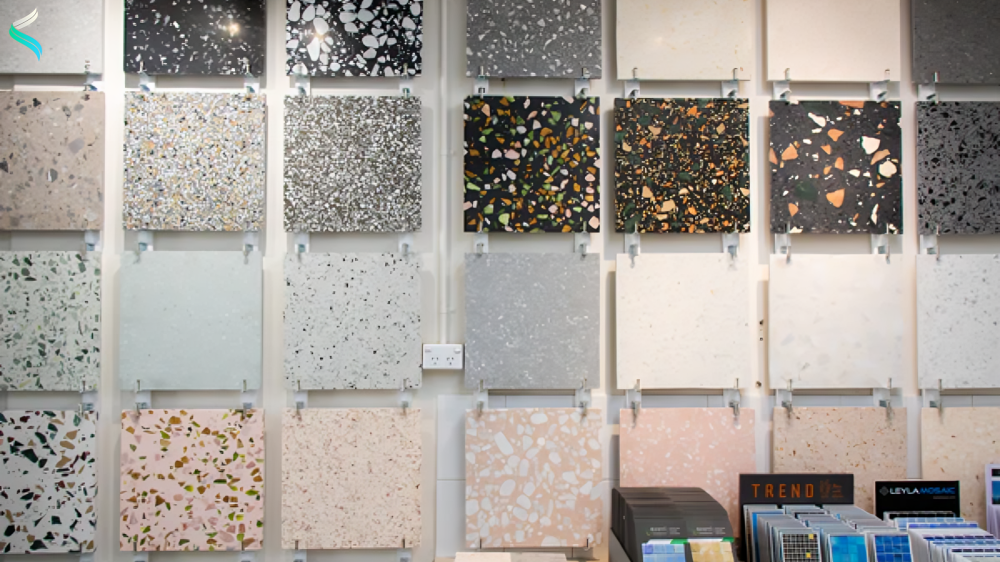Terrazo has been a beloved material in design for centuries, known for its durability, versatility, and aesthetic appeal. Terrazo, which was once thought to be a material of the past, is currently seeing a phenomenal comeback in the world of design. This classic material, originally used in ancient times, is making a modern comeback in both residential and commercial spaces. With its vibrant colors, customizable patterns, and environmentally friendly qualities, terrazo has captivated the attention of designers, architects, and homeowners alike. In this article, we will explore the history of terrazo, its rise and fall in popularity, and the factors that have contributed to its contemporary revival. Additionally, we will look at how terrazo is being used in modern design, how it compares to other materials, and what the future holds for this iconic surface.
What Is Terrazo?
Chips of marble, quartz, granite, glass, or other aggregates are combined with a cement or resin binder to create terrazo, a composite material. These chips are ground down and polished to create a smooth, durable surface that showcases a unique pattern of colors and textures. Terrazo can be applied to floors, walls, countertops, and other surfaces, making it incredibly versatile.
Terrazo’s versatility is what makes it so beautiful. The colors, sizes, and types of aggregates used can be tailored to create a one-of-a-kind look for any space. Whether it’s a traditional terrazo floor with classic marble chips or a more modern variation featuring colorful glass fragments, terrazzo is as diverse as the designer’s imagination.

The History of Terrazo
The origins of terrazo date back to ancient civilizations, where similar composite materials were used in the construction of buildings and artwork. The term “terrazo” itself comes from the Italian word for “terrace,” referring to the outdoor areas where this material was initially used.
In Italy, terrazo became more and more popular in the fifteenth century. Venetian craftspeople were the first to use marble chips mixed with lime and water to create durable flooring surfaces. This early form of terrazo became widely adopted due to its cost-effectiveness and ability to be used in both residential and public buildings.
During the 20th century, terrazo became synonymous with mid-century modern design. It was used in large commercial buildings, schools, and airports, prized for its ability to withstand high traffic while offering a visually striking surface. Terrazo floors were particularly common in the Art Deco era, where geometric patterns and vibrant colors became fashionable.
However, terrazo lost popularity in the 1970s and 1980s. Other flooring materials, such as vinyl, carpet, and wood, took over the market, and terrazo’s popularity declined. For a time, it seemed that this beautiful and functional material had faded into history. But now, terrazo is experiencing a resurgence, driven by new design trends and an increasing focus on sustainability and longevity.
Why Terrazo Is Making a Comeback
Several factors have contributed to Terrazo’s modern-day revival. Let’s explore why this classic material is once again taking center stage in contemporary design.
Sustainability and Environmental Benefits
One of the primary reasons for terrazo’s resurgence is its environmentally friendly qualities. Terrazo is a sustainable option because it uses recycled materials, such as glass, marble, and other aggregates, that would otherwise go to waste. This reduces the need for new raw materials, minimizing environmental impact.
Additionally, terrazo floors are extremely durable, lasting for decades or even centuries when properly maintained. Unlike other flooring materials that need to be replaced or refinished frequently, terrazo requires minimal upkeep and can be refinished multiple times, further extending its lifespan.
In an era where sustainability is at the forefront of design, terrazo’s eco-friendly attributes make it an attractive choice for environmentally conscious architects and designers.
Customization and Versatility
Terrazo’s versatility is another reason why it is making a comeback. The material can be customized to fit any design aesthetic, from traditional to contemporary, making it suitable for a wide range of applications. Designers can mix and match aggregates to create unique patterns and colors, ensuring that terrazo floors, walls, and surfaces complement any interior style.
In addition to its aesthetic flexibility, terrazzo is also available in both cement-based and resin-based forms. Cement terrazzo is the traditional method, while resin terrazzo is a more modern approach that allows for quicker installation and a wider variety of finishes. Terrazzo can be tailored to your preferences, whether you want a matte, industrial vibe or a glossy, polished appearance.

Durability and Longevity
Terrazo is renowned for its durability. The material is incredibly strong and resistant to wear and tear, making it ideal for high-traffic areas. Whether used in commercial buildings, kitchens, or bathrooms, terrazzo can withstand heavy foot traffic, spills, and stains without losing its charm.
Over time, terrazzo is a cost-effective option due to its extended lifespan. While the initial installation may be more expensive than other materials, the durability of terrazzo ensures that it will last for decades, providing excellent value for money. This makes terrazzo an attractive option for homeowners, business owners, and property developers who are looking for a material that can stand the test of time.
Aesthetic Appeal
Terrazzo has an undeniable visual appeal. The chips of marble, glass, and other aggregates create a colorful, speckled effect that adds interest and texture to any space. Terrazzo can be made to fit any taste, whether you want strong, vibrant hues or a classic, neutral palette.
The material’s ability to reflect light gives it a luminous quality, making it a favorite choice for both floors and countertops. Terrazzo is often used to create eye-catching features in bathrooms, kitchens, and entryways, where its unique patterns can have a dramatic impact.
Furthermore, terrazzo pairs well with a wide range of other materials, such as wood, metal, and stone, allowing it to seamlessly integrate into a variety of design schemes. Its timeless appeal ensures that it works in both modern and traditional interiors.
Design Trends Favoring Retro and Vintage Styles
As design trends continue to embrace the past, terrazzo has experienced a resurgence due to the growing popularity of retro and vintage styles. Mid-century modern design, which was heavily influenced by terrazzo, has made a strong comeback, with designers looking to incorporate the material into new spaces.
The playful patterns and colorful aggregates of terrazzo lend themselves well to retro esthetics, and many designers are incorporating it into contemporary spaces as a nod to the past. The combination of nostalgia and modern design sensibilities has helped bring terrazzo back into the spotlight.
How Terrazo Is Used in Modern Design
Terrazzo is extremely adaptable and may be utilized in a variety of ways. Some of the most popular uses for terrazo today include:
Flooring
Terrazo is perhaps most commonly associated with flooring. It is perfect for both business and residential settings because of its strength and beauty. Modern terrazzo floors can be found in homes, offices, hotels, and public buildings, where they serve as both functional and decorative elements.
The material’s ability to be customized with different colors and patterns makes it a perfect choice for creating unique and personalized flooring designs. Terrazo floors can be made to fit your style, whether you want muted hues or striking, vivid hues.
Countertops
Terrazzo counter tops are getting more and more popular in kitchens and toilets. The material’s durability makes it a practical choice for surfaces that experience frequent use, while its stunning appearance adds visual interest to any space.
Terrazzo countertops can be crafted in a variety of colors, making it easy to match them with other design elements in the room. Whether you select a classic marble terrazzo or a greater modern layout with glass chips, terrazzo countertops make a formidable assertion.

Wall Cladding and Backsplashes
In addition to floors and countertops, terrazzo is also being used for wall cladding and backsplashes. Terrazzo wall panels can create a striking feature in kitchens, bathrooms, and living spaces, providing a sense of texture and luxury. The versatility of terrazzo allows it to be applied in creative and unexpected ways, making it a great choice for accent walls or as a backsplash behind kitchen sinks.
Furniture and Decorative Objects
Terrazzo is not limited to floors and walls. Many designers are incorporating terrazzo into furniture pieces and decorative objects, such as tables, lamps, and planters. These unique terrazzo accents add a modern, artistic touch to any space, making it a great option for statement pieces.
Outdoor Spaces
Due to its durability and resistance to weather conditions, terrazzo is also being used in outdoor spaces. Terrazzo can be applied to outdoor flooring, pool surrounds, and even garden paths, where its timeless appeal adds sophistication and elegance to any exterior setting.
How Terrazo Compares to Other Materials
When it comes to choosing materials for flooring, countertops, or other surfaces, it’s important to understand how terrazzo compares to other options like marble, granite, and quartz. Here’s a quick comparison:
- Terrazo vs. Marble: While marble is a classic, luxurious material, terrazzo offers more customization options due to its mix of aggregates. Terrazzo is also more durable and resistant to cracks and chips than marble, making it a better choice for high-traffic areas.
- Terrazo vs. Granite: Granite is known for its strength and durability, but terrazzo offers a greater range of colors and designs. Terrazzo is also more sustainable, as it often uses recycled materials, whereas granite requires mining of natural stones.
- Terrazo vs. Quartz: Quartz countertops are non-porous and highly durable, but terrazzo has the edge when it comes to aesthetic appeal and customization. Quartz is limited to solid colors, while terrazzo offers endless possibilities for creative patterns and color combinations.
The Future of Terrazo
As the trend toward sustainable and customizable design grows, terrazzo is expected to continue its comeback in the coming years. With its eco-friendly qualities, timeless beauty, and versatility, terrazzo will likely remain a popular choice for designers and homeowners alike.
The continued development of new terrazzo products, such as resin-based terrazzo and pre-cast tiles, will make the material even more accessible and easier to work with. As terrazo continues to evolve, it will remain a go-to option for those looking to create beautiful, functional, and sustainable spaces.
More: Reddit
Conclusion
Terrazo is a conventional fabric that has made a super go back to the arena of layout. Terrazzo is becoming more and more popular in both contemporary homes and commercial spaces because of its rich history, adaptability, and environmental advantages. Whether it’s being used for flooring, countertops, or decorative objects, terrazo adds a unique, artistic touch to any environment. As design trends continue to favor sustainability, customization, and timeless beauty, terrazo will remain an enduring favorite for years to come.











